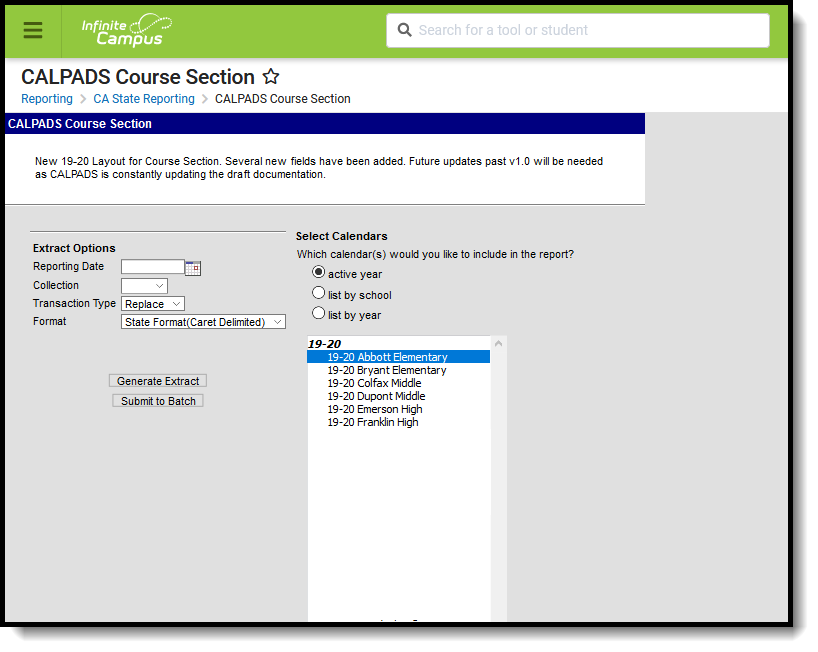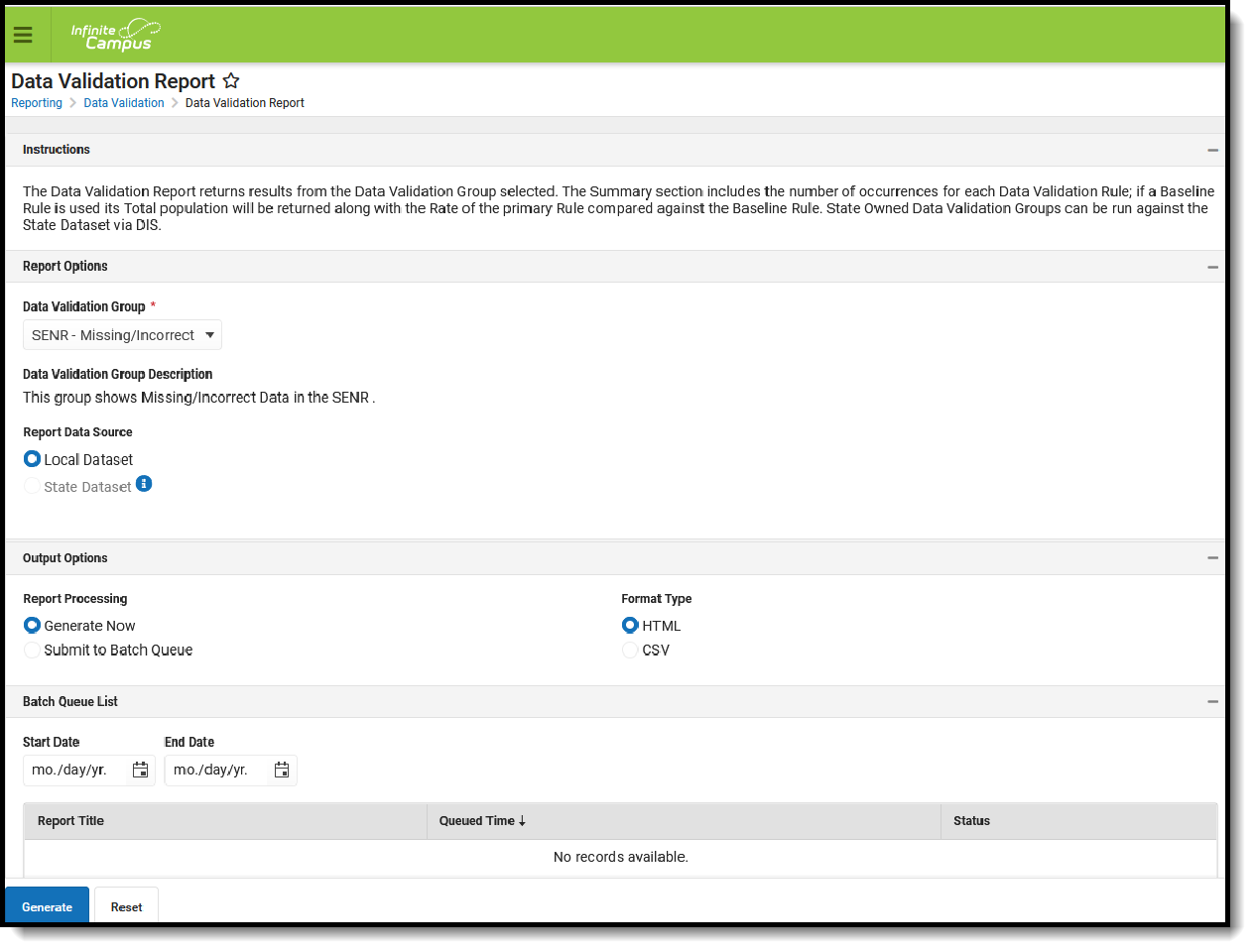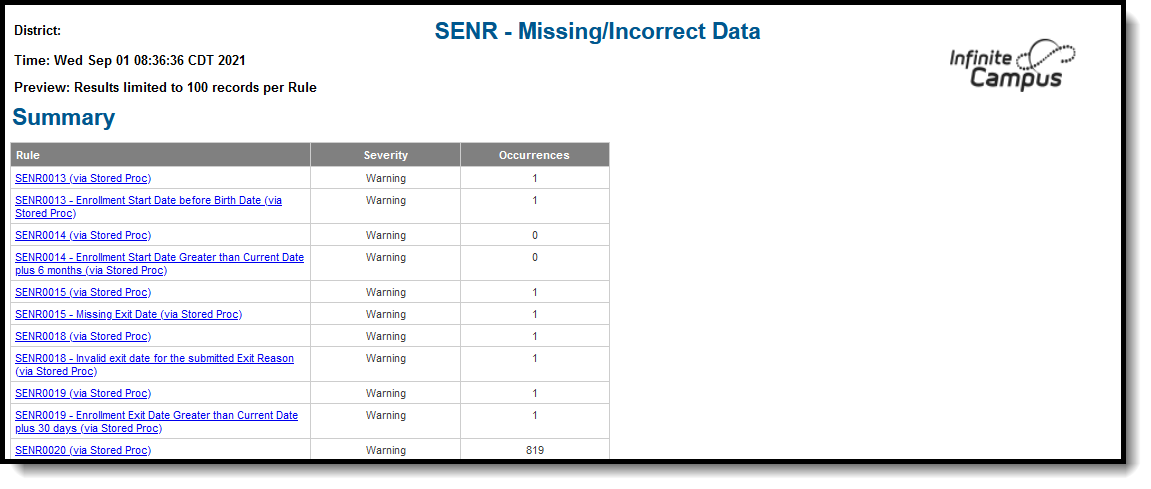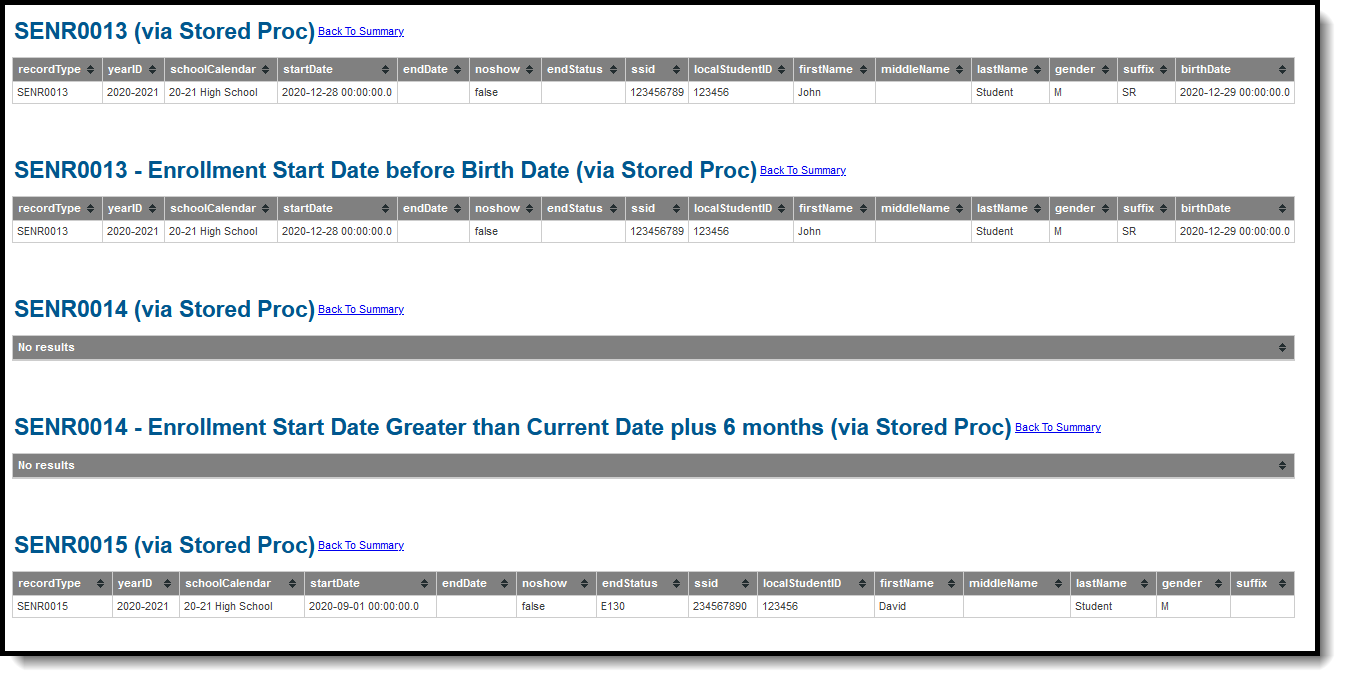Classic View: CA State Reporting > CALPADS Course Section
Search Terms: CALPADS Course Section
The CALPADS Course Section extract reports courses that have students actively enrolled (Fall) or that students have completed (EOY), and the teachers who are teaching the courses. Staff members must have a SEID, and courses taught by staff with a SEID = 9999999999 report. Student data is reported in the CALPADS Student Course Section extract.
Only active courses are included in the report.
 CALPADS Course Section
CALPADS Course Section
Report Logic
For Fall submission, all course sections with students actively scheduled into them on the Reporting Day are included in the report. If the Reporting Day is not an Instructional Day, the first day after the Reporting Day that IS an instructional day is used as the Reporting Day. If the school has a multi-day schedule (A/B or MTWThF, for example), all courses that occur in the term that contains the Reporting Day report. Courses in future terms do not report. There is no grade level constraint on this submission.
One line per Class ID reports, even when the section is scheduled into more than one period/schedule structure.
Course sections that do not have students on the roster report only if the teacher assigned to the section has a Type of 27: Itinerant or Pull-Out Push-In Teacher. The course section must be scheduled in the term that contains Reporting Day. It is acceptable for such a course to be scheduled in an non-instructional period.
For EOY submission, data should be submitted for all course sections completed during the year for students in grades 7-12. A completed course is defined as any course from the current school year in which a student has a mark entered for a grading task designated as "Post to Transcript." That grading task will usually be named something like Final Grade. The course doesn't have to be posted to the transcript at the time of reporting.
Operational Keys
- School of Course Delivery
- Academic Year ID
- Academic Term Code
Unique Identifiers
- School of Course Delivery
- Academic Year ID
- Academic Term
- Local Course ID
- Course Section ID
This is a FULL REPLACEMENT file. This means that if a file is posted to the CALPADS database, and a later file with the same School of Assignment and Academic Year is posted, the records from the second file will replace, rather than update or add to, the records from the first file. Data that has been manually entered into CALPADS will also be replaced if it is not corrected in Infinite Campus as well.
For all collections:
If a course section has multiple teachers (Primary Teacher and Teacher(s), a record is reported for each teacher, as long as the Multiple Teacher element on the course is not null. If there are multiple teachers but that element is null, only the Primary Teacher reports.
- (Fall version) The teacher reported is the active Primary Teacher as of the Reporting Date. An active teacher is determined using the dates on the Section Staff History record.
- (EOY version) The teacher reported is the active Primary Teacher as of the last day of the term on which the section is scheduled. An active teacher is determined using the dates on the Section Staff History record.
Course Section data is not reported for a course without a State Code or a course with a State Code of 6012 or 6017.
Course Section data is not reported if all students are:
- marked as State Exclude.
- enrolled in a Grade Level marked as State Exclude.
- attending a school marked as State Exclude.
Course Section data is not reported if none of the students on the roster have an active enrollment with a Service Type P or S or if there are no students on the roster on the Reporting Day, unless the teacher has an active District assignment with Type 27.
For the EOY Collection:
- All Course Sections in the selected calendar report as long as those courses:
- Have a State Code other than 1000, 6012, 6017 or blank.
- Have/had at least one student in Grade 07-12 (State Grade Level) who has a mark entered for a grading task designated as Post to Transcript. The task does not have to be posted to the transcript at the time of reporting.
- Students do not have to be actively enrolled at the time of reporting, but they must have an enrollment with Service Type P or S at some time during the Academic Year.
- Students who have a Service Type of N are not reported.
Records sort first by School of Course Delivery, then by SEID, then by Course Section ID.
Validate CRSE Data
Use the Data Validation Report to correct any student data prior to the submitting the CALPADS file to the state. Validation Groups and Validation Rules are provided by Infinite Campus for a specific CALPADS extract (listed below). These groups are used to return certain rules assigned to each group.
Modifications to the Validation Rules and Validation Groups can be made if your district has purchased the Campus Analytics Suite; otherwise, they are read-only.
Users can select the Missing or Incorrect Data Validation Group, which returns any missing or incorrect data that is reported in the CALPADS Extract, like a missing enrollment exit reason or an incorrect date, for example.
Note that examples refer to CALPADS SENR.
 Data Validation Report - Missing/Incorrect Data
Data Validation Report - Missing/Incorrect Data
The report first lists a Summary of the issues found and the total number of occurrences.
 Validate Report Summary List
Validate Report Summary List
Then, click the Rule in the Summary column (for HTML format), or scroll through the report to see which students meet the criteria of the rule logic.
 Validate Report Results
Validate Report Results
Refer to the tables below, which includes the rule, rule logic and location, for correcting the data.
Missing or Incorrect Data
The Missing or Incorrect Data Report uses the following rules and logic (open the Click here to Expand section below to see each rule).
Report Editor
Field | Description |
|---|---|
Reporting Date | Indicates the date of the report. This field displays the current date. |
Collection | Indicates the type of Course Section Report that is being generated - Fall (course enrollment) or End of Year (course completion). |
Transaction Type | Indicates the type of transaction that will occur:
|
Format | Selection indicates the format type of the extract. Use the State Format (Caret Delimited) when submitting the information to the state. Use the CSV or HTML format when verifying and testing student data. |
Calendar Selection | Select the calendar(s) of enrollment from which to pull course data. Calendars can be chosen by the active year, by the school name or by the year. |
Report Generation Options | Choose the Generate Extract option to generate the report immediately. Choose the Submit to Batch option to generate the report at a specified time. This option is helpful when generating large amounts of data. |
Generate the Course Section File
- Enter the Reporting Date in mmddyy format, or use the calendar icon to select a date. For Fall 1, use Information Day. This is not needed for EOY.
- Select the Collection from the dropdown list - Fall or EOY.
- Select the Transaction Type from the dropdown list - Replace (default) or Delete.
- Select the Format of the file. The State Format (Caret Delimited) should be chosen when submitting records to the state. Other formats available for testing and review purposes are CSV and HTML.
- Select the Calendars to include in the file.
- Click the Generate Extract button. Or generate the extract at a specified time using the Submit to Batch button. The file appears in a new window in the selected format.
Course Section File
Data Elements | Description | Location |
|---|---|---|
Record Type Code | Type of data record being submitted. Chosen on the Extract Editor.
Alphanumeric, 4 characters | Data not stored |
Transaction Type Code | Action CALPADS should take with this record. Chosen on the Extract Editor.
Alphanumeric, 1 character | Data not stored |
Local Record ID | N/A | N/A |
Reporting LEA | A unique identifier for the educational service institution in which the Staff person is employed. If the reporting calendar is from a School with Type = 15: Independently Reporting Charter, the State School Number reports (not the State District Number). This field reports the Secondary District Number when the reporting calendar has a School Type of 16: Secondary State District Number. Numeric, 7 digits | System Administration > Resources > District Information > State District Number District.number System Administration > Resources > School > School Number School. number System Administration > Resources > School > Type School.type |
School of Course Delivery | A unique identifier for the school that delivers a majority of educational instruction and services and is where the student attends. District-level courses and staff will report from a "School" that has the State District Number entered as the State School Number. If the CDS Number field is populated on the School editor, that value reports. Numeric, 7 digits | System Administration > Resources > School > State School Number School.number System Administration > Resources > School > CDS Number |
Academic Year ID | A unique identifier assigned to a specific Academic Year. An Academic Year is the period during which school is in regular session and provides a required number of days of instruction. Date field, 9 characters (CCYY-CCYY) | System Administration > Calendar > School Years > Start Year/End Year Calendar.schoolYear |
State Course Code | The State Code (Course Group State, formerly known as the CBEDS Subject Code) for a course. Alphanumeric, 4 characters | Scheduling > Courses > Course > State Code Course.stateCode |
Local Course ID | A unique identifier assigned to a course by the local educational agency. When this number is longer than 10 characters, only the first 10 characters report. If the number is less than 10 characters, the entire number reports. Alphanumeric, 10 characters | Scheduling > Courses > Course > Number Course.courseNumber |
Course Name | Name of the course. Alphanumeric, 50 characters | Scheduling > Course > Course > Name Course.name |
Filler Field | N/A | N/A |
Filler Field | N/A | N/A |
CTE Postsecondary Articulated Course | Indicated whether a Career Technical Education course has been designated as a Postsecondary Articulated Course, a course within a CTE technical career pathway or program that has been articulated with a postsecondary education institution. Successful completion of an articulated course may result in the student meeting the prerequisite requirements for a higher-level course in this course sequence upon enrollment in a postsecondary institution.
Alphanumeric, 1 character | Scheduling > Courses > Course > Postsecondary Articulated Course.vocationalCode |
UC-CSU Approved | Indicates the course has been approved as meeting A-G course requirements.
Alphanumeric, 1 character | Scheduling > Courses > Course > UC/CSU Code Course.ucUSCCode |
Course Section ID | A unique identifier for a Course Section assigned by a local educational agency. This field reports the last five digits of the courseID from Campus, along with the last five digits of the sectionID from Campus. If the courseID and/or sectionID is less than five digits, the numbers are padded at the beginning.
Alphanumeric, 10 characters | Scheduling > Courses > Course > Number; Course.number Section.Number |
Academic Term Code | An indicator of the term structure into which the year is divided for the purpose of instruction. If there is a value in the Academic Term field on the Course Section, that value reports. Otherwise, the value is calculated from the Schedule Placement of the Course, as described in the Academic Term Code/Marking Period Code. The field reports blank when a code cannot be calculated and a code is not entered on the Section editor. Alphanumeric, 2 characters | Scheduling > Courses > Course > Section > Academic Term SectionPlacement. Section.academicTerm |
SEID | A unique identifier assigned to each Educator in the California public education system by the California Commission on Teacher Credentialing.
Alphanumeric, 10 characters | Census > People > Demographics > Person Identifiers > Staff State ID Person.staffID Scheduling > Courses > Course > Section > Staff History StaffHistory.Teacher Section.multipleTeacherCode |
Local Staff ID | A unique identifier assigned to a Staff member by the local educational agency.
Alphanumeric, 10 characters | Census > People > Demographics > Person Identifiers > Staff Number Person.staffID |
Class ID | A unique identifier for a class derived at the local level. It must be unique within the academic year. This is not reported for EOY. If a section is taught by multiple teachers, the Primary teacher's classID reports for all course sections. Alphanumeric, 20 characters | Scheduling > Courses > Course > Section Course.courseID System Administration > Calendar > Calendar > ID Calendar.calendarID |
Course Instructional Level Code | A Course Non-Standard Instructional Level indicates that the content of a specific course is either above or below a standard course instructional level. When the Academic Level 2 field has a selection of the following, that code reports.
For other selections in the Academic Level 2 field, see the California Course and Seciton article for a list of options. Numeric, 2 digits | Scheduling > Courses > Course > Academic Level 2 Course.honorsCode |
Education Service Code | A coded value representing an Education Service. An Education Service is a specific service or services that are performed within an Education Service Category. Data is reported but not stored in CALPADS. Reports the code selected in the EL Instructional Type field or the set default value; otherwise the field reports blank if there is no code selected or if a default value is not set. See the California Course and Section article for a list of options. Numeric, 1 character | Scheduling > Courses > Course > Section > EL Instructional Type Section.elInstructionType |
Language of Instruction Code | The primary (non-English) language in which instruction is provided or received. This is required when the Education Service Code is 1: Primary Language Instruction and Designated and Integrated ELD Instruction. Data is reported but not stored in CALPADS. Numeric, 2 digits | Scheduling > Courses > Course > Section > Language of Instruction Section.languageOfInstruction |
Instructional Strategy Code | A coded value representing the Instructional Strategy used to deliver course content. Data is reported but not stored in CALPADS, except for codes 300: Home and Hospital or 700: Special Education. Reports the selected code set on the Section or the default value if one is set; otherwise the field reports blank if there is no code selected or if a default value is not set. Numeric, 3 digits | Scheduling > Courses > Course > Section > Instructional Strategy Section.instructStrategy |
Independent Study Indicator | An indication of whether or not a course section is taught by way of independent study, which is defined as students working independently, according to a written agreement and under the general supervision of a credentialed teacher. Alphanumeric, 1 character | Scheduling > Courses > Course > Section > Independent Study Section.independentStd |
Distance Learning Indicator | An indication of whether or not instruction was delivered by way of distance learning.
A value assigned at the Section level overrides a the value assigned at the Course level. Alphanumeric, 1 character | Scheduling > Courses > Course > Section > Distance Learning Section.distance Code Scheduling > Courses > Course > Distance Learning Course.distanceCode |
Multiple Teacher Code | Coded value representing the Multiple Teacher Code. Data is reported but not stored in CALPADS for EOY. Numeric, 1 digit | Scheduling > Courses > Course > Section > Multiple Teacher Section.multipleTeacherCode |
Education Program Funding Source Code | A coded value representing an Education Program that represents a particular source of previous or current funding. Reports blank if no code is selected.
Numeric, 4 digits | Scheduling > Courses > Course > Section > Program Funding Source Section.prgmFundingSrc |
CTE Course Provider Code | A coded value representing the Career Technical Education Course Provider Category. Reports blank if no code is selected.
Alphanumeric, 1 character | Scheduling > Courses > Course > CTE Funding Provider Course.cteFundProvider |
| Course Content Area Subcategory | Reports the assigned Content Area Subcategory for state codes that require a subcategory. See the California Course and Section article for more information. Numeric, 7 digits | Scheduling > Courses > Course > Course Content Area Subcategory Course.embeddedCourseNumber |
| Departmentalized Course Standards Grade Level Range Code | Reports the grade level range code assigned to the course. Alphabetic, 3 characters | Scheduling > Courses > Course > Grade Level Range Code Course.courseLevel |
| Content Standards Alignment Code | Reports the assigned code indicating which content standards were used to develop the course content. This field exists on both the Course Editor and the Course Section editor. Information reports first from the Section editor; if the field is not populated there, information reports from the Course editor. When the Departmentalized Course Standards Grade Level Range Code reports a value of NOT, this field reports a value of 3. Numeric, 1 digit | Scheduling > Courses > Course > Section > Content Standards Alignment Code Scheduling > Courses > Course > Content Standards Alignment Code Course.contentStandard |
| Charter Non-Core, Non-College Prep Course Indicator | Indicates whether a charter school has identified a course as non-core, non-college preparatory. This field exists on both the Course Editor and the Course Section editor. Information reports first from the Section editor; if the field is not populated there, information reports from the Course editor. This field reports a value of Y when the Charter Non-Core, Non-College Prep Course Indicator is marked on the Section editor. Alphabetic, 1 character (Y or N) | Scheduling > Courses > Course > Section > Charter Non-Core, Non-College Prep Scheduling > Courses > Course > Charter Non-Core, Non-College Prep Course.charterNonCoreNonCollegePrep |
| AP/IB Course Code Cross Reference | Reports the State Course Code of an Advanced Placement or International Baccalaureate course that is part of a career technical education pathway. Numeric, 4 digits | Scheduling > Courses > Course > AP/IB Course Code Cross Reference Course.wblCourseType |
| Online Course Instruction Type Code | Indicates how online courses are taught - by the instructor, by a facilitator, or by the learners. When the Distance Learning Indicator (field 24) reports a value of N or blank, this field reports the assigned value of Online Course Instruction Type from the Section editor first; if that field isn't populated, it then reports from the same field on the Course editor. Alphabetic, 1 character | Scheduling > Courses > Course > Section >Online Course Instruction Type Scheduling > Courses > Course > Online Course Instruction Type Course.teachingMethod Section.teachingMethod |
| Middle School Core Course Indicator | Indicates whether a course is being taught in a middle school core setting (two blocked periods of math and science taught by a teacher in grades 5-8, for example). When the Grade Level Range Code field reports a value of MID, this field reports a value of Y when the Middle School Core Course Indicator field is marked. Alphabetic, 1 character (Y or N) | Scheduling > Courses > Course > Section > Middle School Core Course Indicator Section.middleSchoolCoreCourseInd Scheduling > Courses > Course > Middle School Core Course Indicator Course.middleSchoolCoreCourseInd |
| Local Assignment Option Code | Indicates which staff have the appropriate credentials to teach the course. This field exists on both the Course Editor and the Course Section editor. Information reports first from the Section editor; if the field is not populated there, information reports from the Course editor. Numeric, 2 digits | Scheduling > Courses > Course > Section > Local Assignment Option Code Scheduling > Courses > Course > Local Assignment Option Code Course.program |
| High Quality CTE Course Indicator | Indicates whether the course section and teacher meet the High Quality CTE Course qualifications. When the State Course Code field (field 7) reports a code of 700-8999, this field reports a Y. Alphabetic, 1 character (Y or N) | Scheduling > Courses > Course > Section > High Quality CTE Course Indicator Course.highQualityCTEInd Scheduling > Courses > Course >High Quality CTE Course Indicator Section.highQualityCTEIndSection |
Class ID
If Collection is Fall (CRSE), a Class ID is derived for each section as follows (for a reportable section), report the Class ID as PPP-DD-NN-RRR-XXXXX
- PPP = Period Name (last three characters of the first period ID; if the section is scheduled across multiple periods, reports the last two characters of the first period followed by M and the first character of the first period name)
- DD = Day Name (if there is only one period schedule in the calendar, report 1; if there are multiple period schedules in the calendar, report the first character of each period schedule in which the course is scheduled)
- NN = Schedule Name (first two characters of the name of the schedule structure; if there is only one schedule structure in the calendar, reports 1)
- RRR = Room Name (last three characters of the name of the room into which the section is scheduled. If a room number is not assigned, reports 1).
- XXXXX = Person ID of the Primary Teacher
Example: 001-1-1-456-1234 would be SectionID 1609, which meets in first period in a calendar with one period schedule and one schedule structure. It meets in Room 456 and is taught by a teacher with PersonID 1234. If SectionID 1610 was scheduled in the same period/day/schedule and taught by the same teacher, the same Class ID would report on both records.
Example: 3M-MTF-1-1234 would be SectionID 11344, which meets in multiple periods, beginning with Period 3, on days with period schedules named M on-Weds, T ues-Thurs, and F riday in the single schedule. The teacher is represented by PersonID=1234
The whole Class ID cannot be longer than 20 characters including dashes.
- If Collection is EOY (CRSC), report blank.
